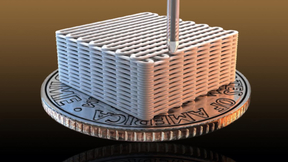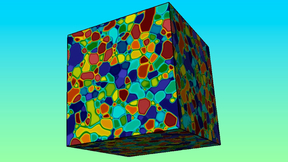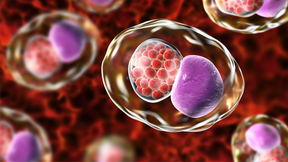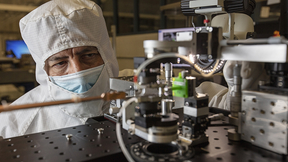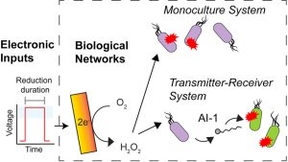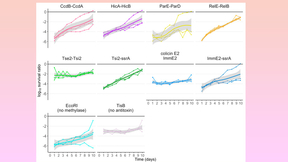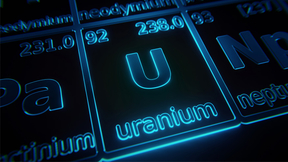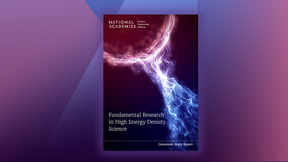Back
Scientists have conducted laboratory experiments at Lawrence Livermore National Laboratory (LLNL) that provide new insights on the complex process of pressure-driven ionization in giant planets and stars. Their research, published today in Nature, unveils the material properties and behavior of matter under extreme compression, offering important implications for…
A Lawrence Livermore National Laboratory (LLNL)-developed technology known as Energy Inks has won a best in region award for the Far West region from the Federal Laboratory Consortium for Technology Transfer (FLC). This is the technology’s second award in the past nine months, as it received an R&D 100 award last September as one of the top 100 industrial inventions in…
Lawrence Livermore National Laboratory (LLNL) and University of California, Davis researchers are assisting Arizona State University with a new laser facility that will use ultrafast pulsed X-ray beams to study biological processes, materials and other research at the atomic level. In March, the National Science Foundation announced that it was awarding $90.8 million to…
New research shows that it is now virtually impossible for natural causes to explain satellite-measured changes in the thermal structure of Earth’s atmosphere. The analysis conducted by Lawrence Livermore National Laboratory (LLNL) scientists and colleagues for the first time demonstrates that extending “fingerprinting” techniques — used to identify the human effects on…
Carbonate minerals are formed when carbon dioxide reacts with magnesium and calcium-rich rocks. But where does that CO2 come from? If it comes from the atmosphere, this process at sufficient scale may be able to reliably draw down atmospheric greenhouse gas levels, according to new research by Lawrence Livermore National Laboratory (LLNL) scientists. The research appears…
Titanium (Ti) and its alloys are attractive for a wide variety of structural and functional applications due to the metal’s excellent strength, toughness and stiffness, and corrosion resistance. Specific applications include lightweight structural materials, bioimplants, and energy storage materials. However, if exposed to hydrogen sources, these alloys are susceptible to…
Chlamydia trachomatis is the most common bacterial sexually transmitted pathogen in the world and can cause ocular, respiratory, and gastrointestinal infections. As the number of chlamydial infections continues to increase, there is a growing and urgent need for the development of a safe and efficacious vaccine. In a new study, researchers from LLNL and UC Davis tested…
The dangers of coastal erosion are an all-too-familiar reality for the modern residents of California’s iconic mountainous coastal communities. With a new tool, researchers are now bringing historical perspective to the topic of how to manage these disappearing coastlines. Using a model that incorporates measurements of the amount of time coastal cliffs and their remnant…
Part 8 in a series of articles describing the elements of Lawrence Livermore National Laboratory's fusion breakthrough. The intricate, delicate targets used in Lawrence Livermore National Laboratory (LLNL)’s National Ignition Facility (NIF) experiments are marvels of design, engineering and precise manufacturing. “We’ve been working over the last 16 years on continuously…
Lawrence Livermore National Laboratory (LLNL) is celebrating National Physics Day (April 24) by highlighting just a few of the thousands of physicists that work at the Lab. Physics is a scientific practice that seeks to understand the way the universe behaves by examining properties of matter and energy. Representing a cross-section of the broad scope of focus areas and…
Cell death and lysis (breakdown of a cell) play an important role in a wide array of biological processes. Scientists propose that the genetic “programming” of microbial cell lysis could provide new methodologies for biomanufacturing and biocontainment. To this end, LLNL and collaborators at the University of Maryland are focused on developing robust and generalizable…
In 1888, Walther Nernst proposed a universal relation between a charged particle’s electrophoretic mobility (a solute’s velocity in response to an applied electric field) and its diffusion coefficient (the rate at which a particle free-diffuses through medium). The microscopic origins of this relation were revealed in 1905 by Albert Einstein. These works cemented the…
Synthetic biology promises to sustainably produce commodity chemicals, treat human disease, steward the environment, and sustain agriculture. Each of these tasks exploit genetically modified organisms (GMO), but the unintended release (referred to as “escape”) of GMOs or their recombinant (non-native) DNA could disturb native ecosystems in unpredictable ways…
Uranium metal is a recognized nuclear fuel for sodium fast reactors due to its significant thermal conductivity and high burnup capability, among other beneficial properties. However, metallic uranium-based nuclear fuels undergo physical phenomena that are poorly understood on a fundamental level. These phenomena include gaseous swelling, redistribution of constituents, or…
There is a growing interest in understanding the performance and properties that make ultra-high temperature ceramics (UHTCs) promising for extreme environment applications, such as hypersonic platforms, nuclear reactors, and atmospheric re-entry. UHTCs are inorganic materials that exhibit metallic conductivity with melting temperatures above 3000 °C. One such material,…
Four Lawrence Livermore National Laboratory (LLNL) postdoctoral appointees have been selected to attend the 72nd annual Lindau Nobel Laureate meeting in Germany this summer thanks to the University of California President’s 2023 Lindau Nobel Laureate Meetings Fellows Program. The four selected to attend are Wonjin Choi, Sean Leonard, Sijia Huang and Sarah Sandholtz. The…
Through machine learning, a Lawrence Livermore National Laboratory (LLNL) scientist has a better grasp of understanding materials used to produce hydrogen fuel. Water is everywhere in the environment and its interaction with metal oxide surfaces has a key role in processes that range from wetting, dissolution and corrosion to photocatalytic reactions. The relative…
Part 5 in a series of articles describing the elements of Lawrence Livermore National Laboratory's fusion breakthrough. If Lawrence Livermore National Laboratory (LLNL)’s National Ignition Facility (NIF) were a race car, it would run at the redline most of the time. “NIF is the only laser system that intentionally operates above the laser damage growth threshold,” said…
Lawrence Livermore National Laboratory scientists have developed a theoretical model for more efficient molecular-level simulations of cell membranes and their lipid-protein interactions, part of a multi-institutional effort to better understand the behavior of cancer-causing membrane proteins. Developed under an ongoing collaboration by the Department of Energy (DOE) and…
The National Academies of Sciences, Engineering, and Medicine released a report, Fundamental Research in High Energy Density Science, which identifies key challenges and science questions for the field of High Energy Density (HED) science for the coming decade and proposes ways to address them. The report follows a year-and-a-half-long consensus study by a committee of 13…


